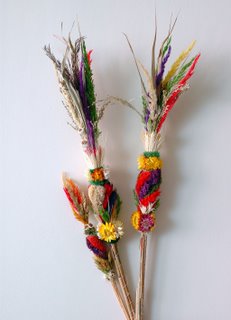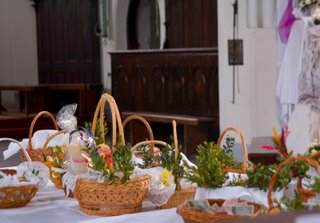Polish Easter Traditions

Well, Easter is over… unfortunately. It is always anticipated impatiently and then passes so quickly. Every student ( and a teacher) is waiting for this spring holiday to catch some breath and to have some fun. Why? Well…
Easter in
Next important day is Holy Thursday. In churches bells fall silent and rattles and clappers take their place. On Good Friday Christian community commemorates Jesus’ path to crucification. In the evening many people go to church for a special service called “The Adoration of the Cross”.
The power of tradition is particularly visible on Holy Saturday, when crowds of people head for churches with beautiful baskets filled with food called “święconka”.
 The preparation of the baskets is perhaps the most popular Easter ritual. The baskets, which are lined with white napkins, usually contain coloured hard-boiled eggs, bread, cold meats, horseradish, pepper, salt and of course – Easter sugar lamb. Another popular Polish tradition is painting Easter eggs – children like it very much. The easiest way to get eggs of a golden-brown colour is to put the eggs into a pot filled with water and onion skins. The longer the eggs are boiled the darker the colour they obtain. In some regions they scratch beautiful floral patterns on eggs boiled this way. After these preparations families go together to church bringing with them the food in their Easter baskets to be blessed by a priest and eaten next morning at Easter table. On Easter Sunday many families sit down to Easter table after the Resurrection Mass, which is held at dawn. The whole family gathered at the festive table pass around best wishes. Then, especially in big cities the whole family go for a walk from church to church to admire the decorated symbolic tombs of Christ.
The preparation of the baskets is perhaps the most popular Easter ritual. The baskets, which are lined with white napkins, usually contain coloured hard-boiled eggs, bread, cold meats, horseradish, pepper, salt and of course – Easter sugar lamb. Another popular Polish tradition is painting Easter eggs – children like it very much. The easiest way to get eggs of a golden-brown colour is to put the eggs into a pot filled with water and onion skins. The longer the eggs are boiled the darker the colour they obtain. In some regions they scratch beautiful floral patterns on eggs boiled this way. After these preparations families go together to church bringing with them the food in their Easter baskets to be blessed by a priest and eaten next morning at Easter table. On Easter Sunday many families sit down to Easter table after the Resurrection Mass, which is held at dawn. The whole family gathered at the festive table pass around best wishes. Then, especially in big cities the whole family go for a walk from church to church to admire the decorated symbolic tombs of Christ.
The funniest moments, however, happen on Easter Monday or Wet Monday. In

2 Comments:
Dear Barbara,
Thank you very much for what you have written about Polish Easter traditions.Although I have visited Warsaw recently,I didn't have the opportunity to learn anything about your Easter.Now, I much better realize how useful the weblog is to exchange ideas and thoughts about our countries.I feel that I belong to a big european company where I can get a lot of benefits from my partners.
Thank you Nada too,for creating this weblog and inviting me to it!
By Kostopoulou Eleni, at 1:19 odp.
Kostopoulou Eleni, at 1:19 odp.
Dear Barbara, your article about Easter was so professional that I used it as teaching material in my English classes. We compared Czech Greek and Polish Easter. It was very interesting to get to know what is similar and what is completely different. I will be happy if you put more articles in this weblog which can be interesting for all of us.
By Naďa Kadlecová, at 10:05 odp.
Naďa Kadlecová, at 10:05 odp.
Okomentovat
<< Home